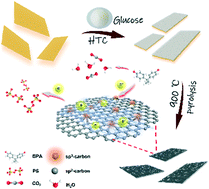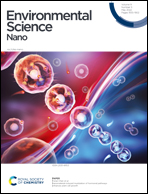Porous carbon nano-sheets as excellent carbocatalysts for organic pollutant removal via persulfate activation: the role of the sp2/sp3 carbon ratio†
Abstract
Carbon-driven persulfate-based advanced oxidation processes have attracted extensive attention for organic pollutant degradation in recent years. Nevertheless, the catalytic activities of carbocatalysts are still unsatisfactory for practical application, and their structure–activity relationships also remain ambiguous. Herein, a series of porous carbon nano-sheets (PCNSs) with tunable sp2/sp3 carbon hybridizations were developed to efficiently remove organic pollutants via persulfate (PS) activation and demonstrate the intrinsic correlation between the structure and the catalytic activity. The optimal catalyst exhibits outstanding catalytic activity in PS activation, which can completely degrade 80 mg L−1 bisphenol A (BPA) in just 45 s. The rate constant (kobs) is up to 7.12 min−1, which is superior to those of all reported catalysts in the remediation of wastewater so far. Moreover, this system exhibits good pH and environmental matrix adaptabilities and also demonstrates excellent catalytic performances for various organic pollutants, presenting great potential for practical applications. Electron paramagnetic resonance (EPR), quenching tests and Raman spectroscopy indicate that holes are the primary active species to degrade BPA through a direct electron transfer process. X-ray photoelectron spectroscopy (XPS) and electron energy loss spectroscopy (EELS) reveal a positive linear relationship between the ratios of sp2/sp3 carbon and the catalytic efficiencies. These findings provide useful insights for the design of high-performance metal-free catalysts and have important implications for persulfate-based environmental remediation processes.

- This article is part of the themed collection: Environmental Remediation


 Please wait while we load your content...
Please wait while we load your content...